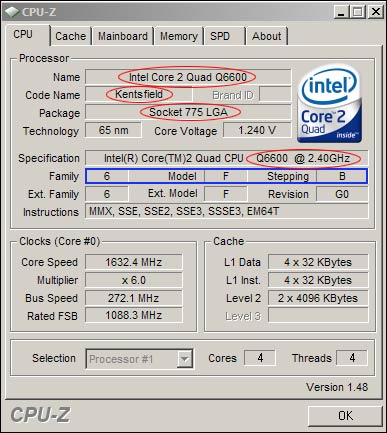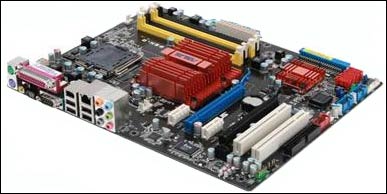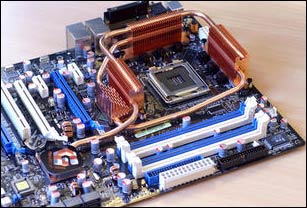How Do You Know if Fan Will Fit in Computer?
How Exercise I Choose a CPU Cooler?
I look you are reading this because you are looking for a new, quieter CPU cooler but are not exactly sure which one is suitable for you lot. Y'all may have looked at the range on offering on our website only have been overwhelmed past the choice available, if so, this is for y'all.
In this video, Andy our Technical Manager explains how to choose a suitable CPU for your system and this supersedes the article below. The tutorial was written in 2008 but we are keeping information technology hither along with the new video tutorial as the steps you lot need to perform to choose a suitable CPU cooler are all the same relevant today.
The original How to Choose a CPU Cooler commodity
I have tried to keep things equally generic as possible so that this article volition still be valid in x years fourth dimension when all current CPU'due south and socket types have get obsolete.
Before I start a note to Dell owners: At the time of writing, Dell employ a lot of not-standard parts in their systems making information technology very difficult for you to actually replace the CPU cooler. The CPU socket may be non-standard as might be the fan connector. A lot of Dell'southward only have a fan fitted on the back or side of the case which blows air down through some ducting onto a heatsink fitted on the CPU. All you lot can practise if your organisation is like this is to replace the fan where possible.
Now, in this the first part, I volition tell yous what you need to know before yous fifty-fifty start looking for a new cooler.
Step 1 – How much heat does my CPU generate?
This is the first question you lot should be asking yourself because if you don't know how much heat is generated then you don't know if you demand a small, medium or large CPU cooler.
If you are lucky and even so have the CPU box, information technology may tell yous on there how many watts of heat information technology generates. If not, yous demand to know the model number. For instance, at the moment the Intel Q6600 generates 95w of heat while most of the Intel Cadre 2 Duo's only generate nigh 65w of estrus. At the other farthermost cease of the scale, the AMD Athlon 64 X2 6400+ generates 125w of estrus.
Then how can you find out? Well currently, if you know your CPU model number, you can become hither - http://www.pchardwarelinks.com/ and search for your CPU model inside your browser. Most modernistic processors tin be found in the Current Processors Chart - http://www.pchardwarelinks.com/current_cpus.htm
This was the upshot for the Q6600:

Equally yous can see there are two versions, one is 105w and the newer version is simply 95w. Likewise handy there is the maximum CPU temperature.
If you don't know your CPU model number then you demand to download a tool chosen CPU-Z from this website - http://www.cpuid.com
Running this volition tell you the name of your processor, its code name, the revision and the socket type used on your motherboard, e.g. 775, AM2, Core I7 (LGA 1366). These are circled in red on the image below.

Also on there is the Family unit, Model and Stepping codes (marked in blue) - 6 F B for this item processor. If yous have found more than than one version of your processor, this will assistance you identify exactly which version you have. In this example, it's the 95w model.
The code name (Kentsfield in our case) is important too because the same processor tin undergo an odd revision and appear more one on that list of processor specifications as you have merely seen with the Q6600. For instance, the AMD Athlon 64 3000+ 1.8GHz appears at least twice, one time as a socket 939 processor (lawmaking proper noun Venice) and again as an AM2 processor (code name Orleans) and both have differing wattage and temperature specifications.
Hither's an instance of the Venice core:

And once more for the Orleans core:
![]()
Step 2 – What size CPU libation exercise I need?
Well, CPU coolers come in all shapes and sizes and information technology's rubber to say that in general, the bigger the heatsink, the more than efficient it is. If information technology is fitted with a fan, then the bigger the improve. Large fans can rotate slowly while yet moving a lot of air and being slower, they are usually much quieter.
If y'all simply have a depression wattage CPU, say 40w to 70w there really isn't much point in going for the largest cooler bachelor, you would be better going for the cheaper, pocket-sized to medium sized CPU coolers.
If you have a CPU around or greater than 70w and then you want to become for the bigger, more efficient CPU coolers.
Stride 3 – Do I need a three-pin fan or a four-pivot (PWM) fan?
Almost if not all motherboard these days have a 4-pin CPU fan header on the motherboard. This is so you tin can set the temperature/speed ratio of the CPU cooler in the BIOS or through supplied utility software that comes with most motherboards.
For instance if the your maximum CPU temperature is 70 °C, you lot could say in the BIOS that the CPU fan can run on its everyman speed until information technology hits 65 °C and and so plough up the speed to say medium or loftier when it gets too hot.
With his method, you practise tend to observe the fan revving upwardly and down so y'all do need to play nearly a bit with those temperature/speed ratio's until you get the balance right.
Also, the amount of control you lot have over the fan speed may range from not much to quite a lot. Generally the more than expensive the motherboard, the more than command you have. On a good lath, yous can accept the fan speed typically anywhere between xl% and 100% of full speed. On a cheaper board you lot may only get the selection of slow, medium or fast!
Many people even so adopt 3-pivot fans considering of the amount of control they offering. If you lot have a 3-pin fan it means that the fan spins at a abiding speed or (by using a fan controller) you lot can change the speed of the fan. They fifty-fifty work on a 4-pin fan header. Unremarkably, you want to turn the fan speed down as far as possible while still ensuring the fan is spinning fast enough to ensure information technology doesn't overheat, no matter what you are doing.
A common misconception is that yous have to keep your eye on the temperature and go on adjusting it at regular intervals. This isn't truthful. Withal yous practise need to set the fan speed while all of the cores in your CPU are under full load. Search the net for such programs. Currently, CPU Burn-in is a pop instance of this type of utility.
If you accept say 4 cores on your processor, run four instances of the programme and adjust the fan speed so that the CPU temperature doesn't become over information technology maximum (but perhaps is v – ten °C lower than maximum). That fashion no matter how much load your CPU is under, you know information technology tin handle information technology. When you lot have done setting the fan, it volition be running slower and quieter than information technology would take been at total speed.
Pace four – The motherboard - Socket types and layout
The very first thing y'all need to do is know most your motherboard is your socket type (see stride 1 if yous are non certain). Popular socket types at the moment (Nov 2008) are 775, AM2 and the new, upward and coming 1336. Then too as choosing a cooler y'all must also choose one that is compatible with your particular socket blazon.
Currently, a lot of CPU coolers are compatible with most of the pop socket types although there are some only support one socket blazon.
Abreast the socket type, the layout of the motherboard can too determine which cooler's will or won't fit. Take this lath for instance:

...if you accept a motherboard like this, which is relatively un-cluttered around the CPU area, you tin probably fit just about any compatible CPU cooler on there without a problem.
However, many motherboards these days have a lot of heat pipes surrounding the CPU, like this:

So how do you know what will fit or is virtually likely to fit?
Well it is surprising what you can make it that space. I myself have the motherboard pictured above and also a copper Ninja :

...which is big yet it still fits. Admittedly, clamping information technology downwards in the corners was a bit tricky but every bit always the effect was well worth the effort!
Many cooler which announced quite large have fins which are merely far enough away from the base of the libation to articulate the surrounding heat pipes. Some manufacturers even have a list of pop compatible motherboards on their website for each of their CPU coolers although they are few and far between and don't get updated regularly.
Step five – Existence reasonably sure the cooler will fit.
You may get to a signal where you want a sure CPU cooler simply looking at your motherboard, it might not be obvious if a cooler will fit and you would rather get one that fit'due south first fourth dimension around so you lot are non messing around sending it dorsum and getting another more likely cooler. And then what practise you exercise?
Well, if the area effectually the CPU is pretty cluttered with heat pipes then consider a cooler design which stands proud of the motherboard with a narrow base, ones such every bit these:

from left to right, Noctua NH-C12P, Zalman 9300-AT, Scythe Andy Samurai Main, ASUS Silent Knight II
Footstep 6 – Ensuring information technology fits in your instance
I common reason I get CPU coolers returned is because they were likewise big to fit in a instance. Some of the images on our website can be deceiving, some cooler are in fact pretty alpine (15 cm plus!) so it's ever a proficient idea to take a few measurements within the case and compare those to the measurements listed on the website before you place an order.
Pace seven – If you lot are even so unsure...
Well if all else fails and you are yet unsure what to get, feel costless to e-mail QuietPC technical back up with as much information as possible near your system (see footstep two) motherboard make/model, CPU brand model and if possible, send a articulate picture showing the inside of your case. That way I tin can gauge the infinite y'all have in at that place for a replacement CPU cooler and then recommend appropriately.
Finally, what if it doesn't fit when it arrives?
Nosotros all make mistakes merely non to worry, at QuietPC nosotros won't penalise y'all for that. If your cooler doesn't fit and then by all ways let the states know and we will issue you RMA details and then y'all can return it for a refund and we tin can look at other alternatives.
haydentwiletionly.blogspot.com
Source: https://www.quietpc.com/faq_cpu_cooler_install